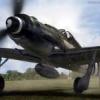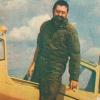Search the Community
Showing results for tags 'Malaya'.
-
IIRC there were two periods when RAF fighters featured black port wing undersides - first lasted from April 1938 until early June 1940 and the second one from the end of November 1940 till April 1941. During the 1st period the starboard wing underside had to be white, while tailplanes and fuselages (although ordered to be divided black/white along the aircraft centreline) were sometimes left in silver or natural metal. During the second (brief) period only port wing had to be black - tailplanes, fuselage and s/board wing remained in Sky Type S. Of course the "black wing" scheme has been applied not only to the single-engined single seaters. Photos of Defiants, Blenheims and Whirlwinds with black port wing are widely known. But there are some pictures showing army co-operation types (Audax, Tomahawk) featuring black port wing. Is it possible that any Hurricanes, Blenheims or Audax with black port wing were still in frontline units during the early stage (up to May 1942) of the war against Japan? Cheers Michael
- 10 replies
-
- black wing
- 1941
-
(and 3 more)
Tagged with:
-
Hi all, I'm currently building a Tamiya 1/48 Dingo mk.II as used by the Federation Armoured Car Regiment in Malaya in 1952-1964. The Malayan Dingos had been handed down by the British Army (some via the Australians) to provide escort duties, roadblocks, reconnaissance and fire support and armoured protection against Communists in the Malayan jungle. The Dingos were modified by British army units in-country to offer better protection against ambush in the jungle. I've used the Tamiya kit and made the armour extensions using plastic sheet. The dimensions are not really exact, but I think I've captured the look of the Dingo reasonably well. This was actually more of a exercise or proof of concept before I convert, and potentially ruin, the bigger (and COSTLIER) MiniArt kit. The Tamiya kit is really well engineered, and goes together very nicely. The progress shown below is the result of a few hours' work over the last weekend. Hopefully, I'll get the interior painted and finished this coming weekend so I can button up the fighting compartment. Now I've got to look for a 1/48 bren gun to arm the little fella.
- 21 replies
-
- 1
-

-
There's a topic in another section concerning limited use of Meteor before the VE-day, so - instead of asking there - I'd rather go for a new topic here, as my question concerns limited combat use of RAF Meteor during the Cold War period. As all we know Meteor and Vampire were not only two first British jet fighters, but also two most numerous ones in whole history with Hunter and Venom (a Vampire half-brother BTW) far behind and all others still more exotic. Both (i.e. Meteor and Vampire) were widely exported and their final users didn't hesitate to use them in combat ranging from minor skirmishes up to the serious conflicts like Korea or Israeli-Arabian wars. AFAIK the RAF also used Vampires in combat against Malayan and Kenyan guerillas (No 45, 60 and 8 Sq.) and flown them operationally in other "hot" areas like Cyprus and Oman. So why wasn't Meteor F.8 combat-tested by RAF, while the contemporary FR.9 made combat sorties over Suez in 1956 and ex-RAF F.8s fought with RAAF No. 77 Sq. in Korea ? Cheers Michael
-
If it isn't too late to join I'd like to participate with my Airfix Blenheim I. It is a lovely little kit with a well appointed interior, options for an open bomb bay and additional external bomb mounts, well engineered positionable landing gear, flap, and turret parts, and two nice decal options in the box. The first of these is for a Romanian aircraft, and the second for an airplane flown by Arthur S. K. Scarf with 62 sqn. in Malaya. On December 9, 1941, Sqn Leader Scarf and a flight of blenheims were taking off for a raid on a Japanese airfield when they were bounced by Japanese fighters. Scarf's aircraft was the only one to get passed and he pressed on to the target. He evaded fighter screans and completed his bomb run. On the return trip, Scarf's aircraft was attacked once again by fighters and he was mortally wounded. He crashlanded his blenheim and saved the lives of his navigator and gunner. For his actions, Scarf was postumously awarded the Victoria Cross. I began the build with the wing. There are two internal spars which form the front and back of the main gear bays, along with some gear strut details to mount inside the housings. All of this, allong with the inner flap surfaces were painted with Humbroll 78 - which looks a tad dark to my eye. Surprisingly, Airfix doesn't offer gear bay side walls, but I'll leave things be, as the idea is to have an enjoyable out-of-box (almost - nearly) build. Almost, because I'm replacing the solid moulded wingtip lights with clear bits, and I may attempt to open up the access hatches. More exciting stuff to follow shortly.
- 7 replies
-
- 1/72
- Out of Box
-
(and 2 more)
Tagged with:
-
Hello! I'm hoping this is the correct place for this post because there isn't a section that I thought worked better but never mind. I am building Airfix's C-47 as a present for my great uncle who jumped out of them during his time serving in the SAS in Malaya and Borneo but I need some help! I have no idea as to what paint scheme the dakotas were in when operated by the SAS during the conflicts in Malaya and Borneo, would anybody on here happen to know? I've done lots of searching in books and on the internet but to no avail. Thank you very much, Ben.






